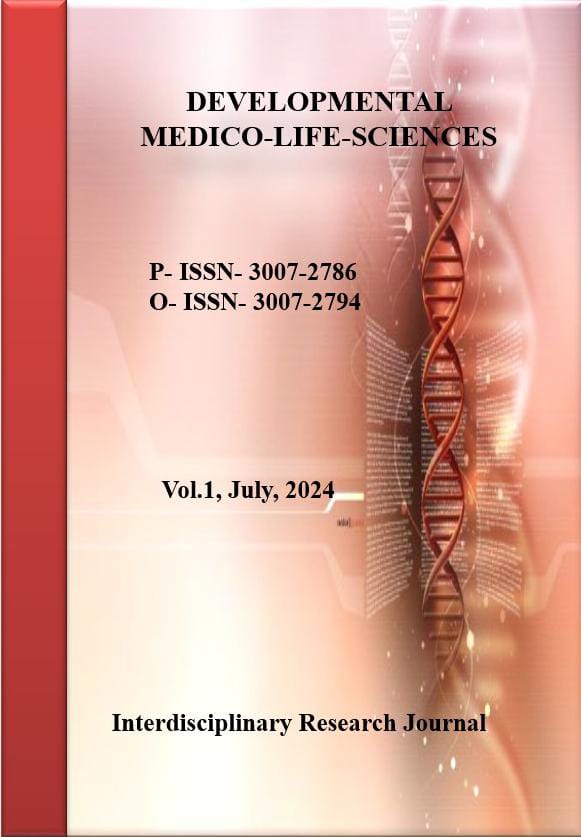Postoperative Pain Management in Patients Undergoing Hernia Repair Surgery. A cross-sectional study
Assessing the Efficacy of Analgesic Regimens in Hernia Repair Surgery
DOI:
https://doi.org/10.69750/dmls.01.05.052Keywords:
Hernia repair surgery, Postoperative pain management, Acetaminophen, Pethidine, Parecoxib, Multimodal analgesia.Abstract
Background: Hernia repair surgery is the most frequently performed surgical operation across the world and pain management after the surgery is important to avoid chronic pain and improve the quality of life.
Objectives: to assess the effectiveness of acetaminophen monotherapy against combination analgesic regimens (acetaminophen plus pethidine or parecoxib) in managing postoperative pain in individuals having hernia repair surgery.
Methods: This was a cross-sectional study on patients who were 18-65 years old and had elective hernia repair surgery. Participants were assigned to three groups: Group A was given IV acetaminophen along with IM pethidine, Group B was given IV acetaminophen with IV parecoxib and Group C was given IV acetaminophen alone. Pain was evaluated by Numeric Rating Scale (NRS) at various time intervals within 24 hours following surgery. Data were analysed employing repeated measures analysis of variance (ANOVA) and multiple regression analysis.
Results: The research had a total of 259 patients. In comparison to Group C, patients in Groups A and B consistently reported far lower pain scores. Group C had the greatest mean pain score (7.91) at 45 minutes post-surgery, whereas Groups A and B demonstrated lower ratings (5.99 and 6.87). Pethidine and parecoxib when paired with acetaminophen were equally effective, as evidenced by the lack of a significant difference between Groups A and B. If acetaminophen monotherapy was used, combination treatment produced better pain relief.
Conclusion: Following hernia repair surgery, combination analgesic regimens comprising acetaminophen and either pethidine or parecoxib are more successful at reducing postoperative pain than acetaminophen monotherapy. As a normal procedure, multimodal analgesia should be taken into account to reduce the incidence of chronic pain and enhance patient recovery.
Downloads
References
Sınmaz T, Akansel N. Experience of Pain and Satisfaction with Pain Management in Patients After a Lumbar Disc Herniation Surgery. Journal of PeriAnesthesia Nursing. 2021;36(6):647-55.doi:10.1016/j.jopan.2021.01.009
Amberbir WD, Bayable SD, Fetene MB. The prevalence and factors associated with acute postoperative pain in elective gynecologic surgical patients at two referral hospitals in Addis Abeba, Ethiopia, 2021: a cross-sectional study. Annals of Medicine and Surgery. 2023;85(6):2506-11.doi: 10.1097/ms9.0000000000000716
Bande D, Moltó L, Pereira JA, Montes A. Chronic pain after groin hernia repair: pain characteristics and impact on quality of life. BMC Surgery. 2020;20(1):147.doi: 10.1186/s12893-020-00805-9
Jakobsson E, Lundström K-J, Holmberg H, de la Croix H, Nordin P. Chronic Pain After Groin Hernia Surgery in Women: A Patient-reported Outcome Study Based on Data From the Swedish Hernia Register. Annals of Surgery. 2022;275(2):213-9.doi: 10.1097/sla.00000000000 05194
Nishikawa M, Fukuda T, Okazaki M. Predictive factors of postoperative acute pain in laparoscopic inguinal hernia repair in men: A single-centre retrospective study in Japan. Journal of Perioperative Practice. 2023;33(5):133-8.doi: 10.1177/17504589211054371
Singh PK, Saikia P, Lahakar M. Prevalence of acute post-operative pain in patients in adult age-group undergoing inpatient abdominal surgery and correlation of intensity of pain and satisfaction with analgesic management: A cross-sectional single institute-based study. Indian Journal of Anaesthesia. 2016;60(10):737-43.doi: 10.4103/ 0019-5049.191686
Özdemir C, Karazeybek E, Söyüncü Y. Relationship Between Quality of Care and Patient Care Outcomes for Postoperative Pain in Major Orthopedic Surgery: Analytical and Cross-Sectional Study. Clinical Nursing Research. 2022;31(3):530-40.doi: 10.1177/1054773821105 9960
Deng X, Liang S, Li H, Gouda D, Zhu T, Xiao K. A cross-sectional study to assess the difference in perception of day surgery information between patients and medical staff in China. Patient Preference and Adherence. 2019;13(null):381-7.doi: 10.2147/PPA.S196674
Olsson A, Sandblom G, Fränneby U, Sondén A, Gunnarsson U, Dahlstrand U. Impact of postoperative complications on the risk for chronic groin pain after open inguinal hernia repair. Surgery. 2017;161(2):509-16.doi: 10.1016/j.surg.2016.08.011
Smith L, Meggy A, Watts T, Knight L, Torkington J, Cornish J. Incisional hernia prevention: risk–benefit from a patient perspective (INVITE) – protocol for a single-centre, mixed-methods, cross-sectional study aiming to determine if using prophylactic mesh in incisional hernia prevention is acceptable to patients. BMJ Open. 2022;12(12):e069568.doi: 10.1136/bmjopen-2022-069568
Malibary N, Shurrab M, Albariqi MO, Bohairi M, Basabain AS, Alqurashi MY, et al. Quality of Life After Umbilical Hernia Repair. Cureus. 2021;13(10):e19016.doi: 10.7759/cureus.19016
López-Cano M, Rodrigues-Gonçalves V, Verdaguer-Tremolosa M, Petrola-Chacón C, Rosselló-Jiménez D, Saludes-Serra J, et al. Prioritization criteria of patients on scheduled waiting lists for abdominal wall hernia surgery: a cross-sectional study. Hernia. 2021;25(6):1659-66.doi: 10.1007/s10029-021-02378-9
Ndong A, Diallo AC, Diao ML, Tendeng JN, Nyemb PMM, Cissé M, et al. Acute postoperative complications increase the risk of recurrence and chronic pain after inguinal hernia surgery: A single-center retrospective analysis. International Journal of Abdominal Wall and Hernia Surgery. 2023;6(4):236-41.doi: 10.4103/ijawhs.ijawhs_47_23
Bragais LCG, Faylona JMV. Adherence to international guidelines for Groin Hernia Management: a retrospective cross-sectional study in a tertiary government training hospital. Hernia. 2020;24(5):969-75.doi: 10.1007/s10029-020-02207-5
Zeleke TG, Mersha AT, Endalew NS, Ferede YA. Prevalence and Factors Associated with Back Pain among Patients Undergoing Spinal Anesthesia at the University of Gondar Comprehensive and Specialized Hospital, North West Ethiopia: An Institutional Based Cross-Sectional Study. Advances in Medicine. 2021;2021(1):6654321. doi:10.1155/2021/6654321
Liu Y, Xiao S, Yang H, Lv X, Hou A, Ma Y, et al. Postoperative pain-related outcomes and perioperative pain management in China: a population-based study. The Lancet Regional Health – Western Pacific. 2023;39.doi: 10.1016/j.lanwpc.2023.100822
Menlah A, OseiAppiah E, Garti I, Frempomaa Agyare D. Factors influencing postoperative pain management among nurses in selected district hospitals in Ghana. Journal of Perioperative Practice. 2023;33(7-8):223-32.doi: 10.1177/ 17504589211064039
Demelash G, Berhe YW, Gebregzi AH, Chekol WB. Prevalence and Factors Associated with Postoperative Pain After Cesarean Section at a Comprehensive Specialized Hospital in Northwest Ethiopia: Prospective Observational Study. Open Access Surgery. 2022;15(null):1-8.doi: 10.2147/OAS.S347920
Slooter CD, Perquin CW, Zwaans WA, Roumen RM, Scheltinga MR, Slooter GD. Laparoscopic mesh removal for chronic postoperative inguinal pain following endoscopic hernia repair: a cohort study on the effect on pain. Hernia. 2023;27(1):77-84.doi: 10.1007/s10029-022-02712-9
Torensma B, Hany M, Bakker MJS, van Velzen M, in ’t Veld BA, Dahan A, et al. Cross-sectional E-survey on the Incidence of Pre- and Postoperative Chronic Pain in Bariatric Surgery. Obesity Surgery. 2023;33(1):204-10.doi: 10.1007/s11695-022-06354-9
Bjurström MF, Irwin MR, Chen DC, Smith MT, Montgomery A. Sex Differences, Sleep Disturbance and Risk of Persistent Pain Associated With Groin Hernia Surgery: A Nationwide Register-Based Cohort Study. The Journal of Pain. 2021;22(11):1360-70.doi: 10.1016/j.jpain.2021.04.008
Chu Z, Zheng B, Yan L. Incidence and predictors of chronic pain after inguinal hernia surgery: a systematic review and meta-analysis. Hernia. 2024;28(4):967-87.doi: 10.1007/s10029-024-02980-7
Bozkurt H, Gür HÜ, Akıncı M, Aslan H, Karakullukçu Ç, Yıldırım D. Evaluation of patients undergoing emergency surgery in a COVID-19 pandemic hospital: a cross-sectional study. Sao Paulo Medical Journal. 2020;138.






















